Abstraction
Tests were carried out on the resistance and weight efficiency of the filter, and the change rules of the dust holding resistance and efficiency of the filter were explored, the energy consumption of the filter was calculated according to the energy efficiency calculation method proposed by Eurovent 4/11.
It is found that the electricity costs of the filter, increases with the raise of time-using and resistance.
Based on the analysis of the filter replacement cost, operating cost and comprehensive cost, a method to determine when the filter should be replaced is proposed.
The results showed that the actual service life of the filter is higher than that specified in GB/T 14295-2008.
The time for filter replacement in general civil building should be decided according to the replacement costs of air volume and operating power consumption costs.
Author Shanghai Institute of Architecture Science (Group) Co., Ltd Zhang Chongyang, Li JingguangIntroductions
The influence of air quality on human health has become one of the most important issues concerned by the society.
Currently, outdoor air pollution represented by PM2.5 is very serious in China. Therefore, the air purification industry develops rapidly, and fresh air purification equipment and air purifier have been widely used.
In 2017, about 860,000 fresh air ventilation and 7 million purifiers were sold in China. With the better awareness of PM2.5, the utilization rate of purification equipment will further increase, and it soon will become a necessary equipment in daily life. The popularity of this kind of equipment is directly affected by its purchase cost and running cost, so it is of great significance to study its economy.
The main parameters of the filter include the pressure drop, the amount of particles collected, the collection efficiency and the running time. Three methods can be adopted to judge the filter replacement time of the fresh air purifier. The first one is to measure the resistance change before and after the filter according to the pressure sensing device; The second is to measure the density of particulate matter at the outlet according to the particulate sensing device. The last one is by the running time, that is, measuring the running time of the equipment.
The traditional theory of filter replacement is to balance the purchase cost and running cost based on efficiency. In other words, the increase of energy consumption is caused by the increase of resistance and the purchase cost.
as shown in Figure 1
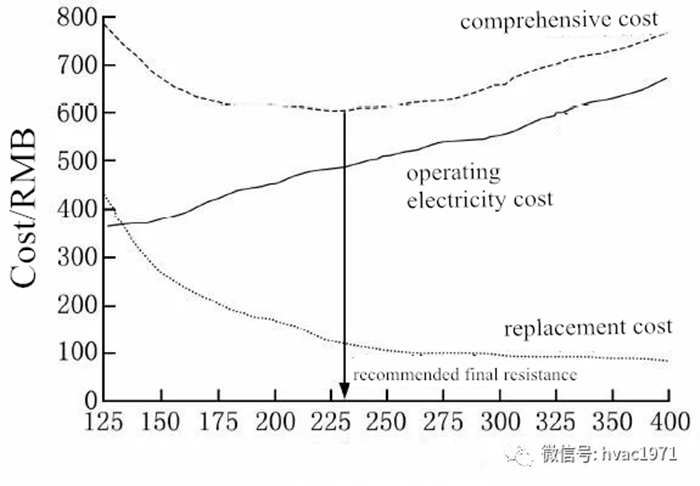
Figure 1 the curve of filter resistance and cost
The purpose of this paper is to explore the frequency of filter replacement and its influence on the design of such equipment and system by analyzing the balance between the operating energy cost caused by the increase of filter resistance and the purchase cost produced by the frequent replacement of filter, under the operating condition of small air volume.
1.Filter Efficiency and Resistance Tests
1.1 Testing Facility
The filter test platform is mainly composed of the following parts: air duct system, artificial dust generating device, measuring equipment, etc., as shown in Figure 2.
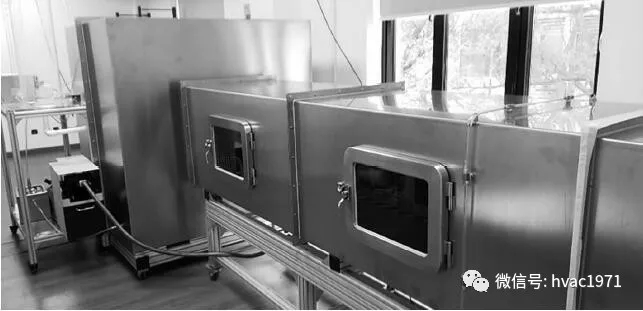
Figure 2. Testing Facility
Adopting the frequency conversion fan in the air duct system of the laboratory to adjust the operating air volume of the filter, thus to test the filter performance under different air volume.
1.2 Testing Sample
In order to enhance the repeatability of the experiment, 3 air filters produced by the same manufacturer were selected. As filters type of H11, H12 and H13 are widely used in the market, H11 grade filter was used in this experiment, with the size of 560mm×560mm×60mm, v-type chemical fiber dense folding type, as shown in Figure 3.
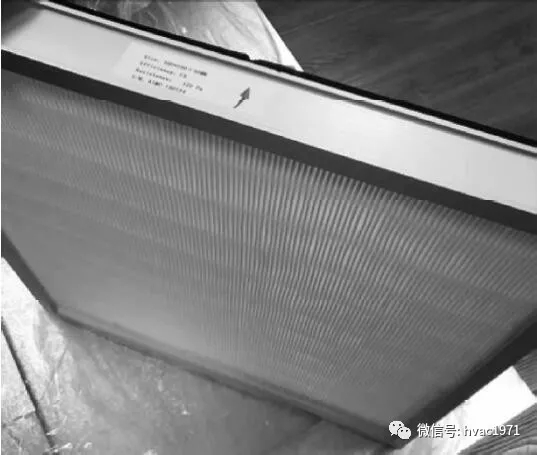
Figure 2. Testing Sample
1.3 Test Requirements
In accordance with the relevant provisions of GB/T 14295-2008 “Air Filter”, in addition to the test conditions required in the test standards, the following conditions should be included:
1) During the test, the temperature and humidity of clean air send into the duct system should be similar;
2) The dust source used for testing all samples should remain the same.
3) Before each sample is tested, dust particles deposited in the duct system should be cleaned with a brush;
4) Recording the working hours of the filter during the test, including the time of emission and suspend of dust;
2. Test Result and Analysis
2.1 Change of Initial Resistance with Air Volume
The initial resistance test was carried out at the air volume of 80,140,220,300,380,460,540,600,711,948 m3/h.
The change of the initial resistance with the air volume is shown in FIG. 4.
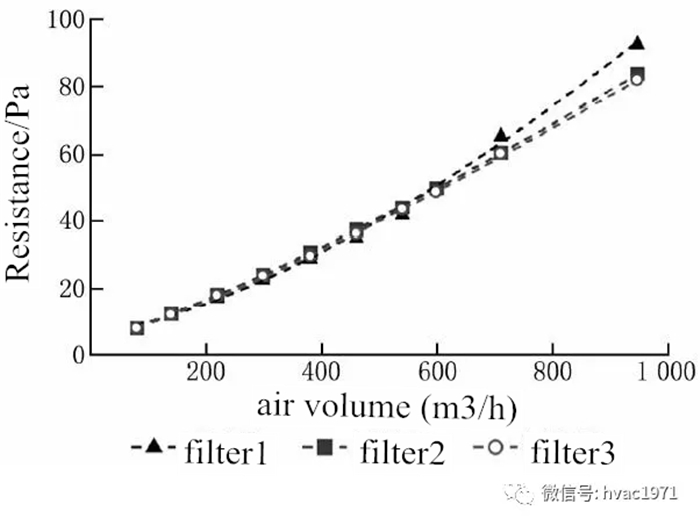
Figure 4. The change of initial resistance of filter under different air volume
2.2 The Change of Weight Efficiency with the Amount of Dust Accumulated.
This passage mainly studies the filtration efficiency of PM2.5 according to filter manufacturers’ test standards, the rated air volume of the filter is 508m3/h. The measured weight efficiency values of the three filters under different dust deposition amount are shown in Table 1
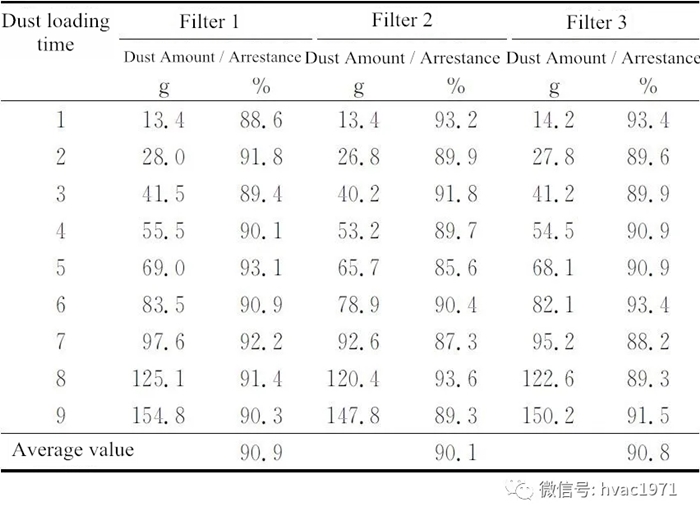
Table 1 The change of arrestance with the amount of dust deposited
The measured weight efficiency (arrestance) index of three filters under different dust deposition amount are shown in Table 1
2.3 The Relation Between Resistance and Dust Accumulation
Each filter was used for 9 times of dust emission. The first 7 times of single dust emission were controlled at about 15.0g, and the last 2 times of single dust emission were controlled at about 30.0g.
The variation of the dust holding resistance changes with the amount of dust accumulation of three filters under the rated airflow, is showed on FIG.5
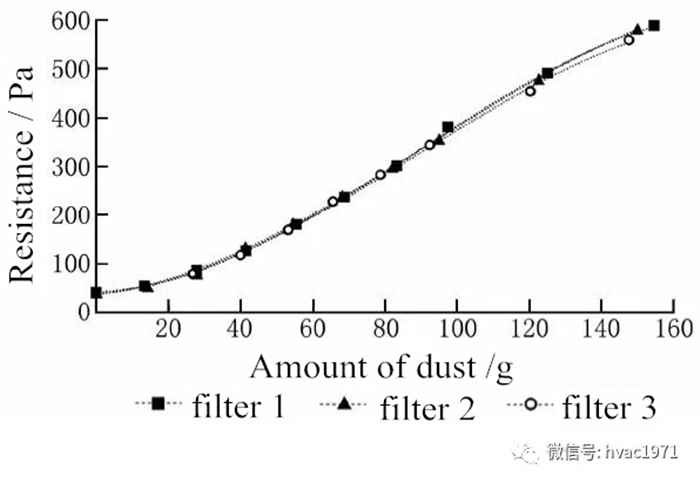
FIG.5
3.Economic Analysis of Filter Usage
3.1 Rated Service Life
GB/T 14295-2008 “Air Filter” stipulates that when the filter operates at rated air capacity and the final resistance reaches 2 times of the initial resistance, the filter is deemed to have reached its service life, and the filter should be replaced. After calculated the service life of the filters under rated working conditions in this experiment, results show that the service life of these three filters was estimated to be 1674, 1650 and 1518h respectively, which were respectively 3.4, 3.3 and 1 month.
3.2 Powder Consumption Analysis
The repeat test above shows that the performance of the three filters is consistent, so filter 1 is taken as an example for energy consumption analysis.
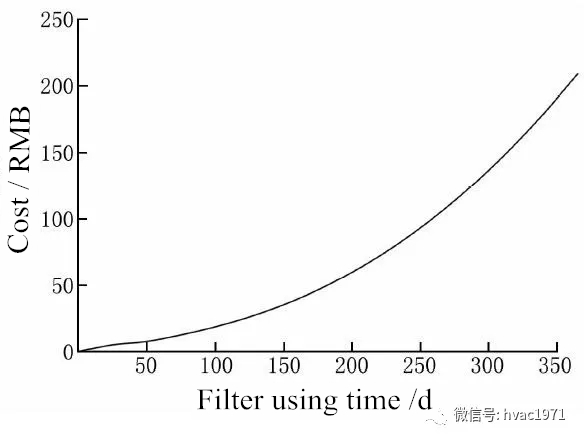
FIG. 6 Relation between the electricity charge and usage days of filter (air volume 508m3/h)
As the replacement cost of air volume changes greatly, the sum of the filter on replacement and power consumption also changes greatly, due to the operating of the filter, as shown in FIG. 7. In the figure, the comprehensive cost = operating electricity cost + unit air volume replacement cost.
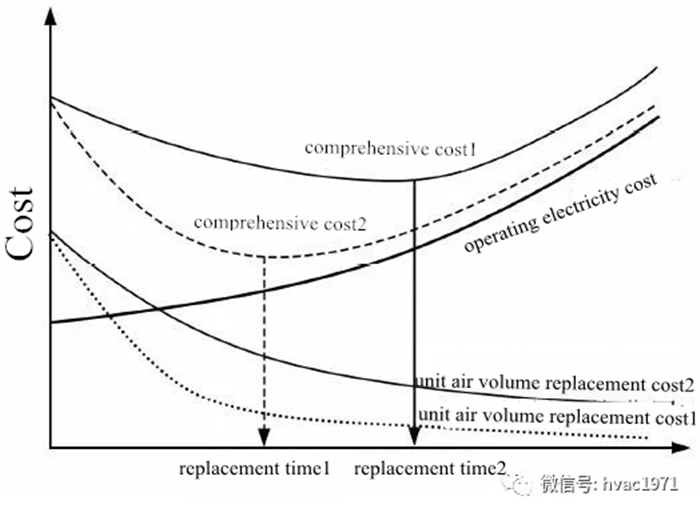
FIG. 7
Conclusions
1) The actual service life of filters with small air volume in general civil buildings is much higher than the service life stipulated in GB/T 14295-2008 “Air Filter” and recommended by current manufacturers. The actual service life of the filter can be considered based on the changing law of the filter power consumption and the replacement cost.
2) The filter replacement evaluation method based on economic consideration is proposed, that is, the replacement cost as per unit air volume and the operating power consumption should be considered comprehensively to determine the replacement time of the filter.
(The full text was released in HVAC, Vol. 50, No. 5, pp. 102-106, 2020)
Post time: Aug-31-2020








